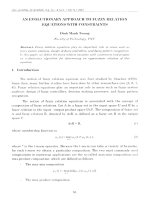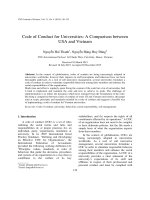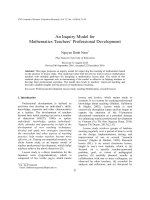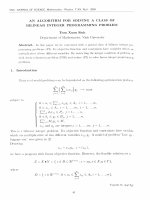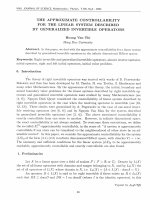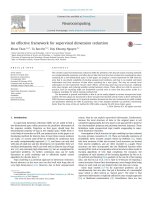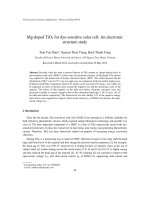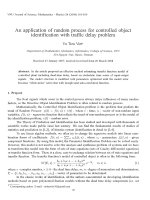DSpace at VNU: An existence theorem for generalized variational inequalities with discontinuous and pseudomonotone operators
Bạn đang xem bản rút gọn của tài liệu. Xem và tải ngay bản đầy đủ của tài liệu tại đây (217.11 KB, 6 trang )
Nonlinear Analysis 74 (2011) 1495–1500
Contents lists available at ScienceDirect
Nonlinear Analysis
journal homepage: www.elsevier.com/locate/na
An existence theorem for generalized variational inequalities with
discontinuous and pseudomonotone operators✩
B.T. Kien a , G.M. Lee b,∗
a
Department of Information and Technology, Hanoi National University of Civil Engineering, 55 Giai Phong, Hanoi, Viet Nam
b
Department of Applied Mathematics, Pukyong National University, Busan, 608-737, Republic of Korea
article
info
Article history:
Received 10 June 2010
Accepted 11 October 2010
Keywords:
B-pseudomonotone operator
K-pseudomonotone operator
C-pseudomonotone operator
Generalized variational inequality
Solution existence
abstract
This paper gives a solution existence theorem for a generalized variational inequality
problem with an operator which is defined on an infinite dimensional space, which
is C-pseudomonotone in the sense of Inoan and Kolumbán [D. Inoan, J. Kolumbán, On
pseudomonotone set-valued mappings, Nonlinear Analysis 68 (2008) 47–53], but which
may not be upper semicontinuous on finite dimensional subspaces. The proof of the
theorem provides a new technique which reduces infinite variational inequality problems
to finite ones. Two examples are given and analyzed to illustrate the theorem. Moreover,
an example is presented to show that the C-pseudomonotonicity of the operator cannot be
omitted in the theorem.
© 2010 Elsevier Ltd. All rights reserved.
1. Introduction
The theory of pseudomonotone operators plays an important role in nonlinear analysis, optimization and variational
inequalities (see [1–10]). There are some kinds of pseudomonotone operators which were studied. One type of
pseudomonotone operators was introduced by Karamardian in 1976 [6] which has been frequently used in optimization
problems (see [2,4,11]). Another type of pseudo-monotone operators was introduced by Brezis in 1968 [12] which has been
used in the study of solution existence of partial differential equations and integral equations (see [13,14]).
It is known that the two mentioned classes of pseudo-monotone operators are different. However, recently, it has
been shown by [3,5] that both notions have a common generalization which is useful for studying generalized variational
inequalities. Namely, under certain conditions, both classes satisfy a property of the so-called C -pseudomonotone operators.
Let us recall some notations and concepts which are related to our problem. Throughout the paper we assume that X is
a topological vector space which satisfies the Hausdoff separation axiom and X ∗ is its dual. Suppose K ⊂ X is a nonempty
∗
closed convex set and Φ : K → 2X is a multifunction from K to X ∗ (which is equipped with the weak∗ topology). We
denote by Gr(Φ ) the graph of Φ , which is defined by
Gr(Φ ) = {(x, x∗ ) ∈ K × X ∗ : x∗ ∈ Φ (x)}.
The generalized variational inequality defined by Φ and K , denoted by GVI(Φ , K ), is the problem of finding a point x ∈ K and
x∗ ∈ Φ (x) such that
⟨x∗ , y − x⟩ ≥ 0 ∀y ∈ K .
(1)
✩ This work was supported by the Korea Science and Engineering Foundation (KOSEF) NRL Program grant funded by the Korea government (MEST)
(No. ROA-2008-000-20010-0).
∗ Corresponding author.
E-mail addresses: (B.T. Kien), (G.M. Lee).
0362-546X/$ – see front matter © 2010 Elsevier Ltd. All rights reserved.
doi:10.1016/j.na.2010.10.022
1496
B.T. Kien, G.M. Lee / Nonlinear Analysis 74 (2011) 1495–1500
Recall that Φ is said to be monotone if for all (x, x∗ ), (y, y∗ ) ∈ Gr(Φ ) one has
⟨x∗ − y∗ , x − y⟩ ≥ 0.
Φ is said to be pseudomonotone in the sense of Karamardian (K -pseudomonotone, for short) if for any (x, x∗ ), (y, y∗ ) ∈
Gr(Φ ) the following implication holds:
⟨y∗ , x − y⟩ ≥ 0 ⇒ ⟨x∗ , x − y⟩ ≥ 0.
It is clear that monotonicity implies K -pseudomonotonicity.
∗
Φ : K → 2X is called pseudomonotone in the sense of Brezis (B-pseudomonotone, for short) if for any u ∈ K and
every net {ui } with ui ⇀ u, u∗i ∈ Φ (ui ), and lim sup⟨u∗i , ui − u⟩ ≤ 0 then for each v ∈ K , there exists u∗v ∈ Φ (u) such
that ⟨u∗v , u − v⟩ ≤ lim inf⟨u∗i , ui − v⟩. It is known that if Φ is monotone and hemicontinuous then Φ is B-pseudomonotone
(see [15, Proposition 27.6]). Moreover, when X is a finite dimensional space, any continuous single-valued map φ : K → X ∗
is B-pseudomonotone. But it is not necessary to be K -pseudomonotone.
∗
According to [5], Φ : K → 2X is said to be C -pseudomonotone if for any x, y ∈ K and net {xi } in K with xi ⇀ x,
sup ⟨x∗ , (1 − t )x + ty − xi ⟩ ≥ 0,
x∗ ∈Φ (xi )
∀t ∈ [0, 1], ∀i ∈ I
implies
sup ⟨x∗ , y − x⟩ ≥ 0.
x∗ ∈Φ (x)
The C -pseudomonotone maps appeared in the literature also under the name of 0-segmentary closed maps, see
for instance [16]. The implications ‘‘B-pseudomonotone implies C -pseudomonotone’’ and ‘‘K -pseudomonotone and
hemicontinuous implies C -pseudomonotone’’ are proved in [5] in the presence of some supplementary conditions. Based on
a characteristic property of C -pseudomonotone operators and using a generalization of the Fan intersection lemma, Inoan
and Kolumbán [5] established an important existence theorem for generalized variational inequalities.
Observe that, in almost all previous results and the result of [5] on the solution existence of GVIs, the continuity of
operator Φ is often required. Namely, solution existence of GVIs is guaranteed under assumptions that Φ is monotone or
pseudomonotone (in some sense) and Φ is upper semicontinuous on finite dimensional subspaces of X (see for instance
[7, Chapter III Theorem 1.4] and [5, Theorem 15]).
One may ask whether the solution existence of GVIs for C -pseudomonotone operators is still valid if operators are not continuous on finite dimensional subspaces.
The aim of this paper is to answer the above question. We will show that if Φ is C -pseudomonotone and satisfies some
additional conditions, the solution existence of GVI(Φ , K ) is still guaranteed even though Φ is discontinuous.
Notice that, there are some papers dealing with solution existence of variational inequalities with discontinuous data
in the literature (see for instance [17,18]). But GVIs were considered in the finite dimensional setting, and the obtained
results were proved and followed directly from the so-called KKM lemma. In this paper the problem is considered in infinite
dimensional spaces. Besides, it seems that our main result cannot follow directly from the Fan intersection lemma [19]. The
obtained theorem is proved by a technique which reduce infinite problems to finite problems. Although the obtained result
is modest, the contribution here is to give a new method of proof.
We are now ready for stating our result.
∗
Theorem 1.1. Let X be a topological vector space and K ⊂ X be convex, closed and nonempty. Suppose that Φ : K → 2X is an
operator which satisfies the following conditions:
(i) Φ is C -pseudomonotone,
(ii) there exist weakly compact subsets B0 , B of K , where B0 ⊆ B and B0 lies in a finite dimensional subspace, such that for every
x ∈ K \ B there exists z ∈ B0 satisfying
sup ⟨f , z − x⟩ < 0,
f ∈Φ (x)
(iii) for each z ∈ K − K , the set {x ∈ K : supx∗ ∈Φ (x) ⟨x∗ , z ⟩ ≥ 0} is closed,
(iv) Φ has convex and weakly∗ compact values.
Then GVI(Φ , K ) has a solution, that is, there exist x0 ∈ B and x∗0 ∈ Φ (x0 ) such that
⟨x∗0 , x − x0 ⟩ ≥ 0,
∀x ∈ K .
B.T. Kien, G.M. Lee / Nonlinear Analysis 74 (2011) 1495–1500
1497
2. Proof of Theorem 1.1
Let us denote by L the family of finite dimensional subspaces L ⊂ X such that B0 ⊂ L. For each L ∈ L, we set BL = B ∩ L
and KL = K ∩ L. It is clear that BL and KL are closed. Fixing any L ∈ L, we define a mapping ΦL : L ∩ K → L∗ by the formula
ΦL (x) = {αL x∗ : x∗ ∈ Φ (x)},
where αL : X ∗ → L∗ is given by
(2)
⟨αL x∗ , y⟩ = ⟨x∗ , y⟩ ∀y ∈ L.
(3)
To prove the theorem we use the following lemma.
n
Lemma 2.1 ([18, Theorem 1.2]). Suppose K ⊂ Rn is a nonempty closed convex set and T : K → 2R is a multifunction which
satisfies the following two conditions:
(a) for each z ∈ K − K , the set {x ∈ K : supf ∈T (x) ⟨f , z ⟩ ≥ 0} is closed,
(b) there exists a compact subset B ⊂ K with the property that for every x ∈ K \ B, there exists z ∈ B such that
sup ⟨f , z − x⟩ < 0,
f ∈T (x)
(c) T has convex and compact values.
Then there exist x0 ∈ B and f0 ∈ T (x0 ) such that
⟨f0 , x − x0 ⟩ ≥ 0,
∀x ∈ K .
Consider the problem GVI(ΦL , KL ). We shall show that GVI(ΦL , KL ) satisfies all conditions of Lemma 2.1.
(a) For each z ∈ KL − KL , z ∈ L and so by (2) we have
{x ∈ KL : sup ⟨f , z ⟩ ≥ 0} = {x ∈ KL : sup ⟨αL x∗ , z ⟩ ≥ 0}
f ∈ΦL (x)
x∗ ∈Φ (x)
= {x ∈ KL : sup ⟨x∗ , z ⟩ ≥ 0} = {x ∈ K : sup ⟨x∗ , z ⟩ ≥ 0} ∩ L,
x∗ ∈Φ (x)
x∗ ∈Φ (x)
which is a closed set by condition (iii) of Theorem 1.1.
(b) Since KL \ BL ⊂ K \ B, it follows from condition (ii) of Theorem 1.1 that for each x ∈ KL \ BL there exists z ∈ B0 ⊂ BL such
that
sup ⟨f , z − x⟩ = sup ⟨x∗ , z − x⟩ < 0.
f ∈ΦL (x)
x∗ ∈Φ (x)
(c) Since Φ has convex and weakly∗ compact values, ΦL has convex and compact values on KL .
Thus all conditions of Lemma 2.1 are fulfilled. According to Lemma 2.1, for each L ∈ L, there exists xL ∈ BL which is a
solution of GVI(ΦL , KL ), that is,
sup ⟨f , y − xL ⟩ ≥ 0 ∀y ∈ KL .
f ∈ΦL (xL )
This is equivalent to
sup ⟨x∗ , y − xL ⟩ ≥ 0 ∀y ∈ KL .
x∗ ∈Φ (xL )
(4)
For each Y ∈ L we denote by SY the set of all xˆ ∈ B such that there exists a subspace L ⊇ Y with the property that xˆ ∈ BL
and
sup ⟨x∗ , y − xˆ ⟩ ≥ 0
x∗ ∈Φ (ˆx)
∀ y ∈ KL .
We claim that the family {S Y } has the finite intersection property, where S Y is the weak closure of SY . In fact, for each Y ∈ L,
by putting L = Y , we have from (4) that xY ∈ SY . Hence S Y is nonempty. Take subspaces L1 , L2 , . . . , Ln ∈ L and put
M = span{L1 , L2 , . . . , Ln }. Then we have M ∈ L and
SM ⊂
n
SLi .
i =1
This implies that
∅ ̸= SM ⊆ S M ⊆
n
i =1
SLi ⊆
n
S Li .
i =1
The claim is proved.
Since S Y ⊂ B and B is weakly compact, the finite intersection property of {S Y } implies
Y ∈L
S Y ̸= ∅.
1498
B.T. Kien, G.M. Lee / Nonlinear Analysis 74 (2011) 1495–1500
This means that there exists a point x0 ∈ B such that x0 ∈ S Y for all Y ∈ L. Fix any y ∈ K and choose Y ∈ L such that Y
contains y and x0 . Since x0 ∈ S Y , there exists a net xi ∈ SY such that xi ⇀ x0 . By definition of SY we have
sup ⟨x∗ , v − xi ⟩ ≥ 0 ∀ v ∈ KY .
x∗ ∈Φ (xi )
In particular, for v = ty + (1 − t )x0 , we get
sup ⟨x∗ , ty + (1 − t )x0 − xi ⟩ ≥ 0 ∀t ∈ [0, 1], ∀i ∈ I .
x∗ ∈Φ (xi )
(5)
Since Φ is C -pseudomonotone, from (5) we get
sup ⟨x∗ , y − x0 ⟩ ≥ 0.
(6)
x∗ ∈Φ (x0 )
To obtain the conclusion we need the following Sion’s minimax theorem (see also [20, Theorem 1]).
Lemma 2.2 ([21, Theorem 3.4]). Let P be a compact convex set in a topological vector space X and Q be a convex subset of a
topological vector space Y . Let h be a real-valued function on P × Q such that
(i) h(x, ·) is upper semicontinuous and quasi-concave on Q for each x ∈ P,
(ii) h(·, y) is lower semicontinuous and quasi-convex on P for each y ∈ Q . Then
min sup h(x, y) = sup min h(x, y).
x∈P y∈Q
y∈Q x∈P
Since y is arbitrary, from (6) we have
sup ⟨x∗ , x − x0 ⟩ ≥ 0,
x∗ ∈Φ (x0 )
∀x ∈ K .
This is equivalent to
min ⟨x∗ , x0 − x⟩ ≤ 0,
x∗ ∈Φ (x0 )
∀x ∈ K .
Hence
sup min ⟨x∗ , x0 − x⟩ ≤ 0.
∗
x∈K x ∈Φ (x0 )
By Lemma 2.2, we get
min sup⟨x∗ , x0 − x⟩ = sup min ⟨x∗ , x0 − x⟩ ≤ 0.
x∗ ∈Φ (x0 ) x∈K
∗
x∈K x ∈Φ (x0 )
(7)
Since the function φ(x∗ ) := supx∈K ⟨x∗ , x0 − x⟩ is lower semicontinuous in the weakly star tolology of X ∗ , there exist
x∗0 ∈ Φ (x0 ) such that φ(x∗0 ) = minx∗ ∈Φ (x0 ) φ(x∗ ). Hence from (7) we obtain
⟨x∗0 , x0 − x⟩ ≤ 0,
∀x ∈ K .
The proof of the theorem is complete.
3. A special case and examples
Let us give a special case of Theorem 1.1 when Φ is upper semicontinuous.
Recall that a multifunction G : K ⊂ X → 2Y , where Y is a topological space, is said to be upper semicontinuous on K if
for any closed set V ⊂ Y , the set {x : G(x) ∩ V ̸= ∅} is closed.
Corollary 3.1 (Cf. [5, Theorem 15]). Let X be a topological vector space and K ⊂ X be convex, closed, nonempty. Suppose that
∗
Φ : K → 2X is an operator which satisfies the following conditions.
(a) Φ is C -pseudomonotone,
(b) there exist a weakly compact subset B ⊂ X and z0 ∈ B such that
sup ⟨f , z0 − x⟩ < 0
f ∈Φ (x)
for all x ∈ K \ B,
(c) for every finite dimensional subspace Z of X , Φ is upper semicontinuous on K ∩ Z , with the weak∗ topology in X ∗ ,
(d) Φ (x) is convex and weakly∗ compact for every x ∈ K .
Then GVI(Φ , K ) has a solution.
B.T. Kien, G.M. Lee / Nonlinear Analysis 74 (2011) 1495–1500
1499
Proof. For the proof we put B0 = {z0 } and show that for each L ∈ L, GVI(ΦL , KL ) has a solution xL ∈ BL = B ∩ L. To do
this we verify all conditions of Lemma 2.1. It is clear that conditions (b) and (c) of Lemma 2.1 are automatically fulfilled for
GVI(ΦL , KL ). It remains to check condition (a).
For each z ∈ KL − KL , we have
{x ∈ K : sup ⟨x∗ , z ⟩ ≥ 0} ∩ L = {x ∈ KL : sup ⟨f , z ⟩ ≥ 0}
f ∈ΦL (x)
x∗ ∈Φ (x)
= {x ∈ KL : ΦL (x) ∩ W ̸= ∅},
where W = {f ∈ L : ⟨f , z ⟩ ≥ 0}, which is a closed set in L∗ . By (c), ΦL is upper semicontinuous on KL , it follows that the
set {x ∈ KL : ΦL (x) ∩ W ̸= ∅} is closed. Hence (a) of Lemma 2.1 is valid. The conclusion follows from the proof method of
Theorem 1.1.
∗
Remark 3.2. The conditions of [5, Theorem 15] are the same as Corollary 3.1 except for the following:
(b)′ there exist a weakly compact subset B ⊂ X and z0 ∈ K such that
sup ⟨f , z0 − x⟩ < 0 ∀x ∈ K \ B;
f ∈Φ (x)
(d)′ Φ (x) is weakly∗ compact for every x ∈ K .
The following are some illustrative examples for Theorem 1.1, where solution existence of GVI(Φ , K ) is guaranteed even
though Φ is discontinuous.
Example 3.3. Suppose X = R, K = [0, 1] and φ : K → R is defined by φ(0) = 0, φ(x) = 1 for all x ̸= 0. Then φ is
C -pseudomonotone and discontinuous at 0. For each z ∈ K − K we have
{x ∈ K : ⟨φ(x), z ⟩ ≥ 0} =
{0}
[0, 1]
if z < 0
if z ≥ 0.
Hence all conditions of Theorem 1.1 are fulfilled. But Corollary 3.1 or Theorem 15 in [5] cannot apply to this example. By a
simple computation, we see that VI(φ, K ) has a solution x0 = 0.
Let us give an example for the case of infinite dimensional spaces.
Example 3.4. Let
X = l2 =
x = (x1 , x2 , . . . , xn , . . .) :
∞
−
|xi | < +∞
2
i=1
and
K = {x = (x1 , x2 , . . . , xk , . . .) : ‖x‖l2 ≤ 1}.
Then K is a convex and weakly compact set in l2 . Let Φ : K → l2 be an operator which is defined by
Φ (x) =
{θ}
{y0 = (1, 0, 0, . . . , 0, . . .)}
if x = θ
if x ̸= θ ,
where θ = (0, 0, . . . , 0, . . .). We would like to check the conditions of Theorem 1.1. It is obvious that conditions (ii) and
(iv) are automatically fulfilled.
Taking any z ∈ K − K , we assume that z = (z1 , z2 , . . . , zn , . . .). Then we have
{x ∈ K : sup ⟨x∗ , z ⟩ ≥ 0} =
x∗ ∈Φ (x)
if z1 < 0
if z1 ≥ 0.
{θ}
K
Hence condition (iii) of Theorem 1.1 is valid. We now claim that Φ is C -pseudomonotone on K . Let x, y ∈ K , xj ∈ K and
xj ⇀ x such that
sup ⟨f , z − xj ⟩ ≥ 0,
f ∈Φ (xj )
∀z ∈ [x, y], ∀j ∈ N .
j
j
j
Let x = (x1 , x2 , . . . , xk , . . .) and xj = (x1 , x2 , . . . , xk , . . .). If x = θ then
sup ⟨f , y − θ ⟩ ≥ 0.
f ∈Φ (θ)
1500
B.T. Kien, G.M. Lee / Nonlinear Analysis 74 (2011) 1495–1500
If x ̸= θ then there exists j0 such that xj ̸= θ for all j ≥ j0 , and so we have
sup ⟨f , z − xj ⟩ = ⟨y0 , z − xj ⟩ ≥ 0,
f ∈Φ (xj )
∀z ∈ [x, y], ∀j ≥ j0 .
(8)
j
Note that since xj ⇀ x, we have xk → xk for all k = 1, 2, . . . . Putting z = y and letting j → ∞, we get from (8) that
sup ⟨f , y − x⟩ = ⟨y0 , y − x⟩ ≥ 0.
f ∈Φ (x)
Hence Φ is C -pseudomonotone and so condition (i) of Theorem 1.1 is valid. Thus all conditions of Theorem 1.1 are fulfilled.
Observe that for any z ∈ K we have
sup ⟨f , z − θ ⟩ = 0.
f ∈Φ (θ)
Hence θ is a solution of VI(Φ , K ). Besides, Φ is discontinuous at θ .
From Example 3.4 one may ask whether GVI(Φ , K ) still has a solution if the assumption on C-pseudomonotonicity of Φ
is omitted. The following example shows that condition (i) of Theorem 1.1 plays an essential role for the solution existence
of GVI(Φ , K ).
Example 3.5. Suppose X = l2 and K is the unit ball in X . Let Φ : K → l2 defined by Φ (x) = ( 1 − ‖x‖2 , x1 , x2 , . . . , xk , . . .)
− x with x = (x1 , x2 , . . . , xk , . . . .). It is clear that Φ is continuous. Hence condition (iii) is valid. Besides, conditions (ii) and
(iv) are automatically fulfilled. However, Φ is not C -pseudomonotone on K . In fact, taking x = θ = (0, 0, . . . , 0, . . .), y =
(−1, 0, 0, . . . , 0, . . .) and a sequence xj = (0, 0, . . . , 0, 1, 0, 0, . . .), where 1 is at the j-th position, we see that xj converges
weakly to x and for all t ∈ [0, 1] one has
⟨Φ (xj ), ty + (1 − t )x − xj ⟩ =
t +1
1
if j = 1,
if j > 1.
But we have ⟨Φ (x), y − x⟩ = −1 < 0. Thus Φ is not C -pseudomonotone on K .
We now show that GVI(Φ , K )has no solution. Conversely, suppose x is a solution of the problem. If ‖x‖ < 1 then we
get Φ (x) = 0. This implies that ( 1 − ‖x‖2 , x1 , x2 , . . . , xk , . . .) = x. Hence ‖x‖ = 1, which is absurd. If ‖x‖ = 1 then the
condition
⟨Φ (x), y − x⟩ ≥ 0 ∀y ∈ K ,
yields Φ (x) = −λx for some λ ≥ 0. This implies 1 = |1 − λ| and so λ = 0 or λ = 2. When λ = 0 then we get ( 1 − ‖x‖2 ,
x1 , x2 , . . . , xk , . . .) = x. From this we obtain x = θ . Also, when λ = 2 we get ( 1 − ‖x‖2 , x1 , x2 , . . . , xk , . . .) = −x. It
follows that x = θ , which contradicts ‖x‖ = 1. Therefore GVI(Φ , K ) has no solution.
Acknowledgements
The authors wish to thank the anonymous referees for their suggestions and comments. This work was also supported
by the Vietnamese Natural Foundation of Science and Technology Development (NAFOSTED).
References
[1] D. Aussel, N. Hadjisavvas, On quasimonotone variational inequalities, J. Optim. Theory Appl. 121 (2004) 445–450.
[2] J.-P. Crouzeix, Pseudomonotone varational inequality problems: existence of solutions, Math. Program. 78 (1997) 305–314.
[3] A. Domokos, Kolumbán, Comparison of two different types of pseudomonotone mappings, in: Seminare de la Theorie de la Meilleure Appromaxion,
Convexite et Optimazation, 2000, pp. 95–103.
[4] F. Facchinei, J.-S. Pang, Finite-Dimensional Variational Inequalities and Complementarity Problems, vols. I, II, Springer, 2003.
[5] D. Inoan, J. Kolumbán, On pseudomonotone set-valued mappings, Nonlinear Anal. 68 (2008) 47–53.
[6] S. Karamardian, Complementarity problems over cones with monotone and pseudomonotone maps, J. Optim. Theory Appl. 18 (1976) 445–454.
[7] D. Kinderlehrer, G. Stampacchia, An Introduction to Variational Inequalities and their Applications, Academic Press, 1980.
[8] B.T. Kien, J.C. Yao, N.D. Yen, On the solution existence of pseudomonotone variational inequalities, J. Global Optim. 41 (2008) 135–145.
[9] B.T. Kien, M.M. Wong, N.C. Wong, J.C. Yao, Solution existence of variational inequalites with pseudomonotone operators the sense of Brézis, J. Optim.
Theory Appl. 140 (2009) 249–263.
[10] I. Konnov, Generalized monotone equilibrium problems and variational inequalities, in: N. Hadjisavvas, S. Komlósi, S. Schaible (Eds.), Handbook of
Generalized Convexity and Generalized Monotonicity, Springer, 2005, pp. 559–618.
[11] J.C. Yao, Multi-valued variational inequalities with K -pseudomonotone operators, J. Optim. Theory Appl. 80 (1994) 63–74.
[12] H. Brézis, Équations et inéquations non linéaires dans les espaces vectoriel en dualité, Ann. Inst. Fourier 18 (1968) 115–175.
[13] F. Browder, P. Hess, Nonlinear mappings of monotone type in Banach spaces, J. Funct. Anal. 11 (1972) 251–294.
[14] P. Hartmann, G. Stampacchia, On some nonlinear elliptic differential functional equations, Acta Math. 115 (1966) 153–188.
[15] E. Zeidler, Nonlinear Functional Analysis and its Applications, II/B, in: Nonlinear Monotone Operators, Springer-Verlag, 1990.
[16] A.P. Farajzadeh, J. Zafarani, Equilibrium problems and variational inequalities in topological vector spaces, Optimization 59 (2010) 495–499.
[17] J.C. Yao, J.S. Guo, Variational and generalized variational inequalities with discontinuous mappings, J. Math. Anal. Appl. 182 (1994) 371–392.
[18] N.D. Yen, On an existence theorem for generalized quasi-variational inequalities, Set-Valued Anal. 3 (1995) 1–10.
[19] K. Fan, A generalization of Tychonoff’s fixed point theorem, Math. Ann. 142 (1961) 305–310.
[20] H. Komiya, Elementary proof for Sion’s minimax theorem, Kodai Math. J. 11 (1988) 5–7.
[21] M. Sion, On general minimax theorems, Pacific J. Math. 8 (1958) 171–176.
